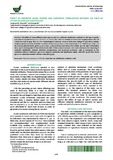| dc.contributor.author | Jongman, M. | |
| dc.contributor.author | Khare, K.B. | |
| dc.contributor.author | Khonga, E.B. | |
| dc.date.accessioned | 2015-11-27T04:40:39Z | |
| dc.date.available | 2015-11-27T04:40:39Z | |
| dc.date.issued | 2013 | |
| dc.identifier.citation | Jongman, M. et al (2013) Effect of different grain spawns and substrate sterilization methods on yield of oyster mushroom in Botswana, International Journal of Bioassays, Vol. 02, No. 10, pp. 1308-1311 | en_US |
| dc.identifier.issn | 2278-778X | |
| dc.identifier.uri | http://hdl.handle.net/10311/1408 | |
| dc.description.abstract | The effect of three different grain spawns and two substrate sterilization methods on the spawn quality
and yield of a hybrid of Pleurotus ostreatus x P. florida (Po x Pf) was studied on maize cobs supplemented with 20% wheat bran and 2% gram flour in a low technological mushroom house at Botswana College of Agriculture, Sebele. Sorghum grains proved to be better mycelium carriers (5.25, 7 days, 12 days and 75.4%) over wheat (2.45, 17 days, 16 days and 53.55%) and barley grains (3.46, 14 days, 13 days and 55.24%) in terms of mycelium growth vigor, colonization time, spawn running time of the substrate and yield of the oyster mushroom. Hot water treatment and steaming of substrate significantly reduced substrate contamination and improved mushroom yield as compared to the
untreated control. Mushrooms grown on steamed substrates had significantly higher yield (BE: 69.4%) than those grown on substrates treated with hot water (BE: 53.3%). | en_US |
| dc.language.iso | en | en_US |
| dc.publisher | Int.J.Bioassays, http://www.ijbio.com | en_US |
| dc.subject | Pleurotus ostreatus x P. florida | en_US |
| dc.subject | Grain spawns | en_US |
| dc.subject | Sterilization methods | en_US |
| dc.subject | Yield | en_US |
| dc.title | Effect of different grain spawns and substrate sterilization methods on yield of oyster mushroom in Botswana | en_US |
| dc.type | Published Article | en_US |
| dc.link | http://www.ijbio.com/index.php/ijb/article/view/185/181 | en_US |

